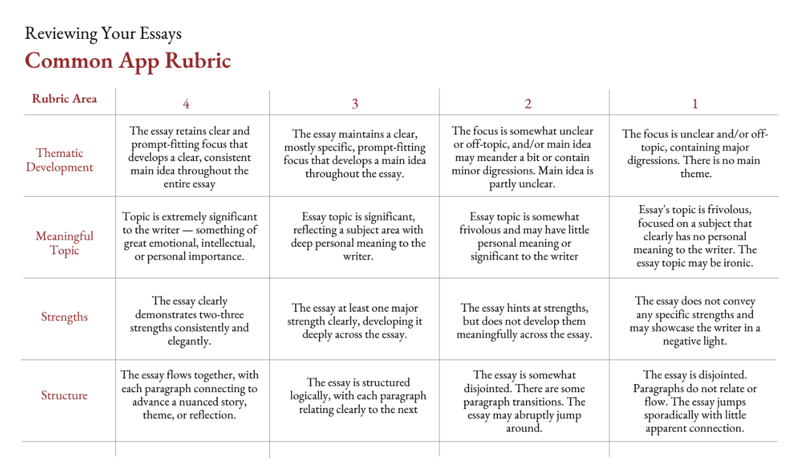Contents
Last updated August 6, 2024
Every piece we write is researched and vetted by a former admissions officer. Read about our mission to pull back the admissions curtain.
The Best College Application Essay Rubric
Admissions officer reviewed by
Ben Bousquet, M.Ed
Former Vanderbilt University
Written by
Kylie Kistner, MA
Former Willamette University Admissions
Key Takeaway
Are your eyes blurry from staring at your college essay for hours on end? It's time to pull out a rubric. Rubrics are scoring tools that can help you identify changes to make before you submit.
If you’re reading this post, you probably have a finished draft of your college essay. Congrats!
Now, you might be wondering: what do I do now?
It’s time to evaluate what you’ve written so you can get to editing.
But evaluating writing is difficult. Different people have different opinions about what a piece of writing should do or look like, so one person may love an essay that another person hates. Unlike disciplines with clearer, more objective solutions to problems (think math or chemistry), writing leaves a lot of room for interpretation.
Even in college admissions, what resonates with one admissions officer may be uninspired to a different one.
But if everyone has different opinions, then how do you know whether what you’ve written is good?
Enter: a rubric.
Rubrics are excellent tools to help you evaluate your writing. They’re those pesky tables that your English teachers have probably stapled to the back of your AP Lit essays.
While rubrics won’t eliminate differences of opinion, they can help you understand how your essay stacks up to a generally agreed-upon set of standardized college essay conventions.
In this post, we break down what a rubric is and how you can use one to score your essay. We also give you some tips for editing after you evaluate your essay.
What is a rubric?
Rubrics can have different layouts. But in general, they are tables that outline the specific criteria that a piece of writing should meet. They often measure factors like organization, theme, grammar, and more.
The table then ranks each of these categories on a numerical scale. A lower score means that the essay needs a lot of improvement in that particular category. A higher score means that the essay excels in that category.
Overall, the point of a rubric is to help you evaluate your own essay in a semi-objective way.
This is important because it gives you guidance about how to proceed with your editing process. Just like you should have a plan before you start drafting, you should also have a plan before you start editing.
Application deadlines will be here before you know it, so being strategic about your editing process will help you use your time efficiently. You’ll know where your essay is weakest, so you can focus most of your effort there. You’ll also know where your essay excels, so you can use those sections to build momentum for the rest of your essay.
Alright—let’s go through the rubric.
College Essay Rubric Breakdown
We developed this rubric to help our Essay Academy students assess their essays. If you’d like to join the ranks of Essay Academy members and get a fuller version of this rubric, check out the Essay Academy program.
But this version is available free for download below. It’s designed specifically for the Common Application, and it lists five categories that all good college essays should excel at.
Thematic Development: What is your essay’s theme, and how well do you develop it?
Meaningful Topic: Is your topic meaningful, deeply personal, and vulnerable?
Strengths: Does your essay convey a core strength?
Structure: How well is your essay organized?
Grammar, Spelling, and Punctuation: Is your essay free of errors? Does it demonstrate skill in standard written English?
Attention to each of these categories is necessary to writing a successful college essay.
To help you evaluate how well your essay does in each category, the rubric lays out a ranking system, with 1 being the lowest and 4 being the highest.
Each column of the table shows a numerical rank and a description of what an essay that scores in that category will look like.
1: The essay does not meet the requirements of the category and needs significant improvements.
2: The essay makes an earnest attempt at meeting the requirements of the category, but it still needs improvement.
3: The essay meets the requirements of the category but does not exceed them.
4: The essay exceeds the requirements of the category. It is exemplary.
These measurements apply to each of the five categories.
An essay that deserves a “4” in “Thematic Development,” for example, will “retain clear and prompt-fitting focus that develops a clear, consistent main idea throughout the entire essay.”

Now that we’ve gotten the rubric basics down, let’s talk about how to score your essay.
How to Score Your Essay with a Rubric
For the rubric to be useful, you’ll need to score your essay in each category. That means that you’ll need to re-read your essay and honestly evaluate it.
First, a brief note on critical evaluation is in order. Throughout the writing process, there are times to be critical of yourself and times to be forgiving. Evaluating your essay is a time to be critical. That doesn’t mean tearing yourself down or being too harsh on yourself. It does mean being realistic with yourself and not sugarcoating your evaluation. It’s better for you to be critical now than for an admissions officer to be critical later. The consequences of you being critical will be a better final draft. The consequences of an admissions officer being critical could be a rejection.
This process is a little tedious, so we’ll go step by step.
Step 1: Before you being reading, explore the rubric thoroughly and understand what each of the categories asks you to do. You might also consider reading our guide to writing a college essay to get a more holistic view of what you’re aiming for.
Step 2: Start by thinking about the first four categories (thematic development, meaningful topic, strengths, and structure). These are the biggest categories that will have the most significant impact on the overall makeup of your essay.
Step 3: Re-read your essay with these criteria in mind, and circle your scores on the rubric. Don’t worry about fixing them quite yet.
Step 4: Then think through the final category (grammar, spelling, and punctuation).
Step 5: Re-read your essay again, paying particular attention to these sections. As you go, feel free to note any glaring errors, run-on sentences, or odd word choice you notice.
Step 6: Circle your grammar score on the rubric
You should now have five total scores, one in each category.
Step 7: Take the lowest scores, and that’s where you’ll start your revisions.
Using a Rubric to Edit Your College Essay
Once you’ve evaluated your college essay, it’s time to begin editing.
Make a list of which revisions you want to prioritize first based on your lowest scores. Look at the description for a “4” score in those categories. What do those descriptions list that your essay doesn’t have? Make note of each thing you need to improve.
Then get to editing. It’s a good idea to copy and paste your essay into a new document so you don’t lose any of your original work, just in case you want to recover anything.
Start with the larger issues first—those of theme, meaning, strength, and structure. You’ll want to prioritize the biggest revisions because those will likely affect all parts of your essay. Prioritizing these first will help you avoid doing work that you’ll later delete anyway.
Once you’re done with your revisions, re-score your essay using the rubric. You can even hand your essay and the rubric to a trusted adult to score. If you still have areas of improvement, revise again.
When you’re scoring 3-4 in every category, you’ll know you’re ready to submit.
(Psst—need more editing help? Let's work together.)



